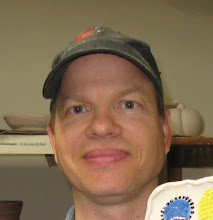I've been working in the studio lately and experimenting with a new technique for decorating some pottery. I'm still using porcelain clay since changing clay types requires a couple hours of cleaning, and I'm too lazy to switch clay types very frequently, since cleaning is not the most productive (nor the most fun) of things to do. I've read about this technique quite a few years ago, and again recently, so I was very willing to give it a try to see what I could do with it.
To make the technique work, I created a mixture of porcelain slip, spanish iron oxide, and sodium silicate, and used a hand mixer to blend it into a smooth but slippery goo. Then it was time to get busy on the wheel to throw a cylinder and give the technique a try. These photos show some of my efforts.
 In the above photo, I'm seated at the wheel using a hot air gun to dry the painted on mixture before the expansion of the cylinder. By expanding the cylinder with only one hand inside, the outside skin of the pot creates a cracking pattern.
In the above photo, I'm seated at the wheel using a hot air gun to dry the painted on mixture before the expansion of the cylinder. By expanding the cylinder with only one hand inside, the outside skin of the pot creates a cracking pattern. The above photo shows the cracking pattern made after the expansion.
The above photo shows the cracking pattern made after the expansion. The spiral line was drawn before the expansion took place.
The spiral line was drawn before the expansion took place. The above photo shows a close up of the cracking patter in the skin of the pot. Pretty cool, no? :D
The above photo shows a close up of the cracking patter in the skin of the pot. Pretty cool, no? :D The above photo shows another porclain cylinder I've thrown on the wheel just as I'm about to spread on the mixture using a brush.
The above photo shows another porclain cylinder I've thrown on the wheel just as I'm about to spread on the mixture using a brush. Using the spinning of the potter's wheel helps to create an even coat of the mixture on the surface of the cylinder.
Using the spinning of the potter's wheel helps to create an even coat of the mixture on the surface of the cylinder. Using the heat gun for a few minutes on the mixture helps it to dry enough so that the cracking occurs as the expansion is done.
Using the heat gun for a few minutes on the mixture helps it to dry enough so that the cracking occurs as the expansion is done. In the above photo, I've drawn some lines in the mixture on the cylinder to make some interesting effects as the expansion happens.
In the above photo, I've drawn some lines in the mixture on the cylinder to make some interesting effects as the expansion happens. As you can see, the expansion has to be done using only one hand on the inside of the cylinder so that the cracking pattern it creates is not smeared on the outside.
As you can see, the expansion has to be done using only one hand on the inside of the cylinder so that the cracking pattern it creates is not smeared on the outside. As the cracking pattern gets more pronounced, the drawn pattern becomes less and less distinquishable.
As the cracking pattern gets more pronounced, the drawn pattern becomes less and less distinquishable. It seems I have to try it again to see if I can try another shape! LOL.
It seems I have to try it again to see if I can try another shape! LOL. So another cylinder is covered in a nice layer of the mixture, ready to be dried and expanded.
So another cylinder is covered in a nice layer of the mixture, ready to be dried and expanded. Here's the drying...
Here's the drying... And the results of the expansion. Even though the outer skin cracks, the inside layer of clay is still pliable enough to not be ripped when expanded from the inside.
And the results of the expansion. Even though the outer skin cracks, the inside layer of clay is still pliable enough to not be ripped when expanded from the inside. After my experimentation using the colored mixture, I decided to make a few other shapes. The above lumpy tumbler is a fun and interesting shape, and can look and feel quite nice if the correct glazes are used.
After my experimentation using the colored mixture, I decided to make a few other shapes. The above lumpy tumbler is a fun and interesting shape, and can look and feel quite nice if the correct glazes are used. Here is another small tumbler/vase.
Here is another small tumbler/vase. The above photo shows a bunch of pieces drying, and they will soon be fired for the first time in the kiln during the bisque firing.
The above photo shows a bunch of pieces drying, and they will soon be fired for the first time in the kiln during the bisque firing.




